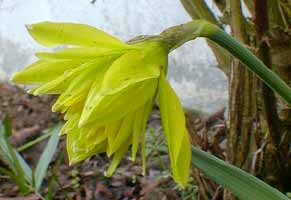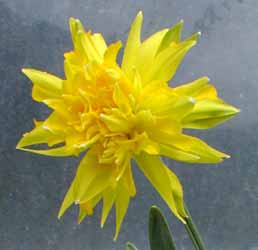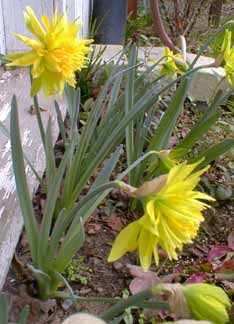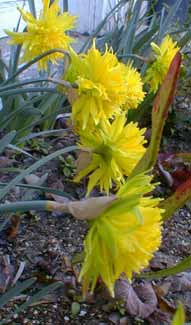
'Rip Van Winkle'
Butterfly Dwarf Narcissus
"It is a rock or cliff on the loneliest part of the mountains, & from the flowering vines which clamber about it, & the wild flowers which abound in its neighborhood, is known by the name of the Garden Rock."
-"Rip Van Winkle"
by Washington Irving
'Rip Van Winkle' is one of the nicer of our miniature daffodils, an Irish Victorian selection that has been around since 1884. It is a very fluffy one to two-inch sunray Double Yellow flower, a scant six to twelve inches tall.
 To be such a short plant, it'll have large green goosehead flower-buds before mid-February, & is invariably one of the very first daffodils to flower.
To be such a short plant, it'll have large green goosehead flower-buds before mid-February, & is invariably one of the very first daffodils to flower.The first portrait above is the very first 'Rip van Winkle' of the season, opening at the tail-end of February, & by the first day or two in March there are 'Rip van Winkles' galore, lasting into April. The second & third photos are from early March.
A few years ago, we planted a few of these at the foot of a trimmed-back Japanese red barberry. together with other miniatures. They did moderately well at first, but the barberry grew back from its trimming so quickly that the narcissus grass was too overshadowed to get the post-flowering sun required by the leaves in order to recharge the bulbs.
 There were some jonquils that did flower almost as well the second year even in the increasing shade, but the 'Tete a Tete' & most especially 'Rip van Winkle' were very unimpressive their second year. So that following autumn I lifted the bulbs & found that some of them had turned into multiple bulbs needing to be separated, & others had gotten rot to them & had to be thrown away. I could not tell the bulbs apart so moved them into a big mixed lot by the road. The following spring, one missed 'Rip Van Winkle' bloomed in the old location under the barberry.
There were some jonquils that did flower almost as well the second year even in the increasing shade, but the 'Tete a Tete' & most especially 'Rip van Winkle' were very unimpressive their second year. So that following autumn I lifted the bulbs & found that some of them had turned into multiple bulbs needing to be separated, & others had gotten rot to them & had to be thrown away. I could not tell the bulbs apart so moved them into a big mixed lot by the road. The following spring, one missed 'Rip Van Winkle' bloomed in the old location under the barberry.At the same time as lifting, separating, & moving the daffodils formery under the barberry, we planted sixteen additional 'Rip Van Winkle' bulbs in front of the basement window where their shortness wouldn't block what light gets into the basement, & in another roadside location, ten more 'Rip van Winkle' bulbs were mixed into a single drift together with the little botanical Tulipa hageri which blooms later, on a ledge in front of our Rhododendron 'Jean Marie.'
 The Rip van Winkles growing in front of a basement window in bright afternoon sun & with some residual heat passing through the glass bloom a week or more earlier than the drift growing by the roadside. The roadside drift gets even more sun & also gets wetter since there are no eaves to keep them dry. The roadside drift being along a stone ledge has perfect drainage, which these bulbs require.
The Rip van Winkles growing in front of a basement window in bright afternoon sun & with some residual heat passing through the glass bloom a week or more earlier than the drift growing by the roadside. The roadside drift gets even more sun & also gets wetter since there are no eaves to keep them dry. The roadside drift being along a stone ledge has perfect drainage, which these bulbs require.It is one of the prettiest of all daffodils, but it does have one fault. 'Rip van Winkle' doesn't tip its head quite so far down as most of the miniatures, though it does tip some, but when the slight tip of the bloom is added to the stem's weighted lean, it sometimes has a fallen-down look. The flowers are too heavy for the stems, so it's one of the tippiest varieties. Their fallen appearance sometimes encourages taking them for bouquets, while other varieties that remain very upright are left in the garden.
Though being "doubles" could have made them excessively gaudy, they're actually fairly subtle, being so short & a more pallid shade of yellow than most daffodils. The petals & trumpets are split into slim segments so that they look much flufflier than they would if they were merely doubles. Additionally they having thicker nearly blue-green leaves that are not immediately reminiscent of daffodils generally.
'Rip Van Winkle' is actually the botanical daffodil, N. minor var. pumilus 'Plenus.' It will bloom so-so even in partial shade, though generally speaking the more sun the better if it is to naturalize & reproduce. It's extremely hardy in our area (Zone 8), but they can be delicate in areas where temperatures fall into the teens; they're not particularly cold-hardy.
Reports on how well they naturalize vary. They ought to do so with great ease, returning year after year in slowly increasing numbers, but a few gardeners have reported them fading from the garden within three years. From my limited experience it seems that they would fail to perennialize only if too shaded, or too moist during summer dormancy, or if the ground freezes them for too long in winter. Even if they do per chance decrease over time, the bulbs are inexpensive & commonly offered, so worth replanting each autumn to insure having them in sufficient numbers every spring.